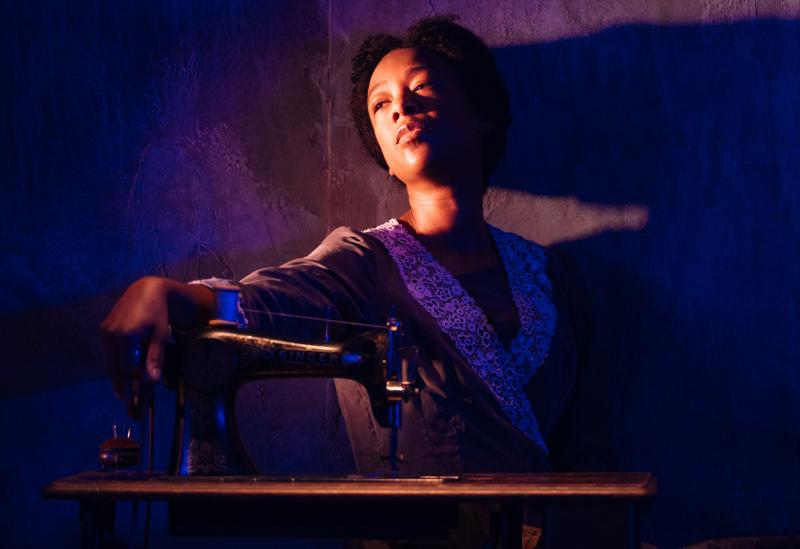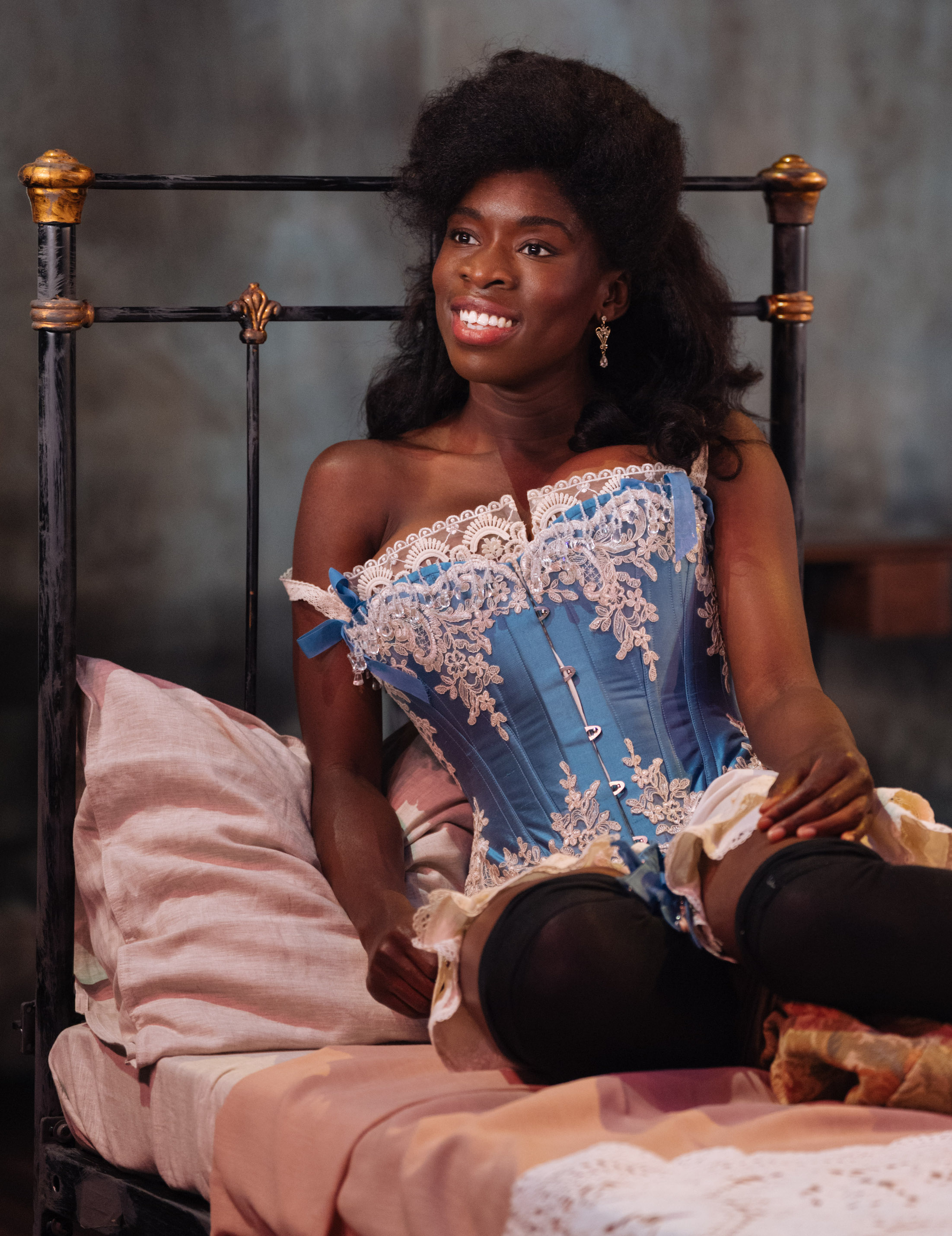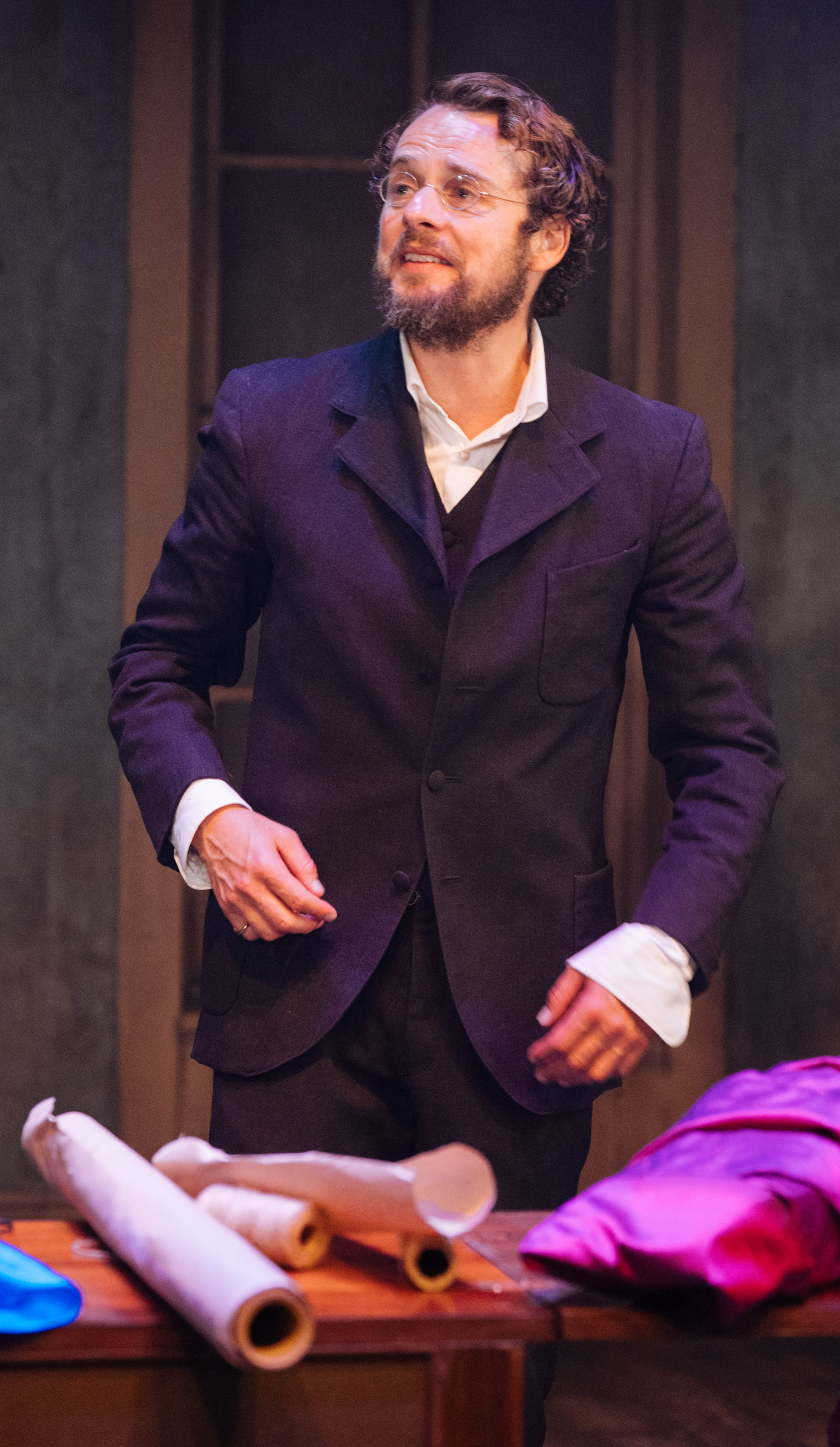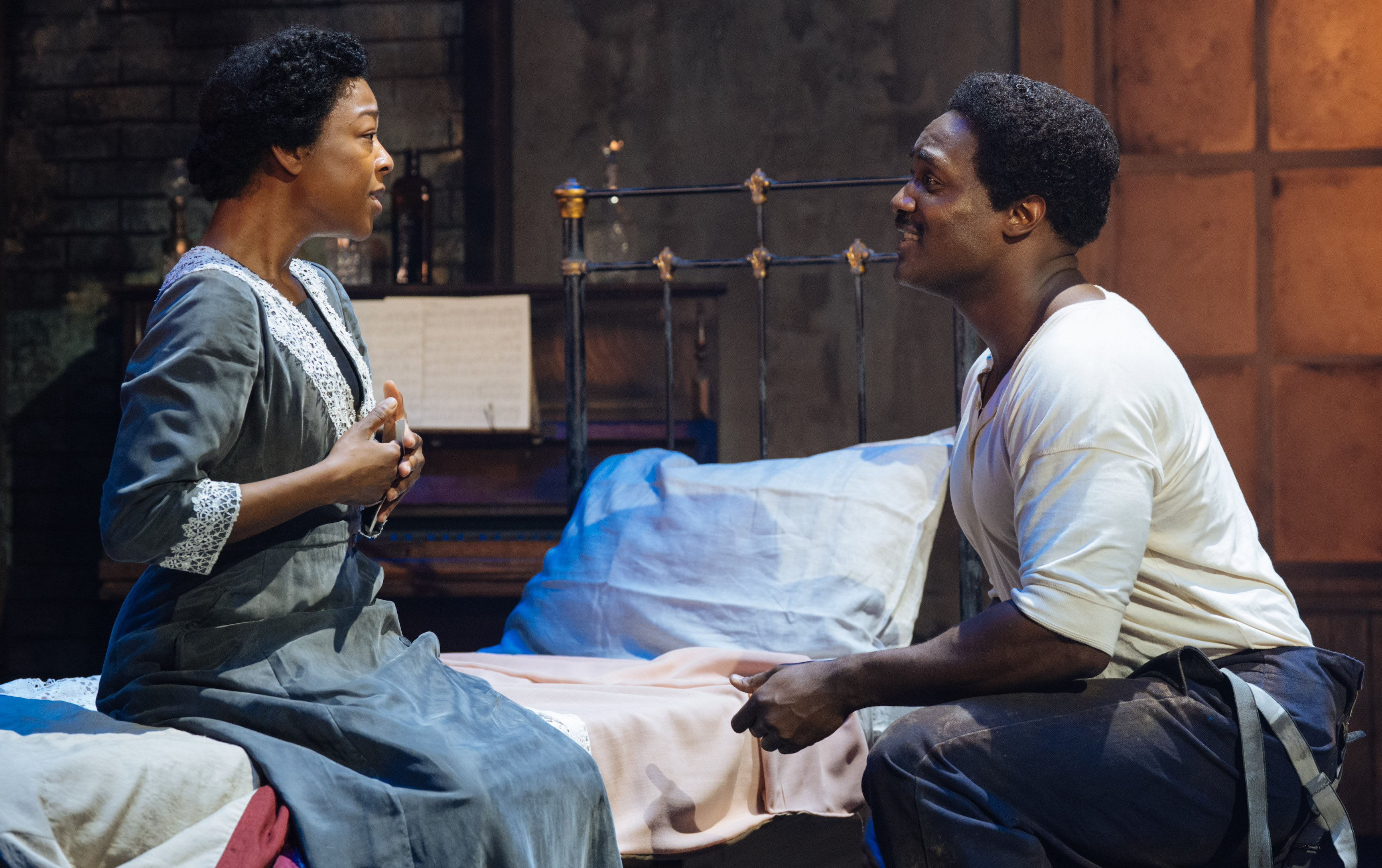Intimate Apparel, Donmar Warehouse review - stirring story of Black survival in 1905 New York | reviews, news & interviews
Intimate Apparel, Donmar Warehouse review - stirring story of Black survival in 1905 New York
Intimate Apparel, Donmar Warehouse review - stirring story of Black survival in 1905 New York
An early Lynn Nottage work gets a superb cast and production

The corset is an unlikely star of the latest Lynn Nottage play to arrive at the Donmar Warehouse, 2003’s Intimate Apparel. After the more male-dominated Sweat and Clyde’s at the same address, this is a personal piece about the lot of Black women, inspired by Nottage’s discovery of an old photo of her great-grandmother Ethel.
She set about excavating all she could about Ethel, but there wasn’t much in print about Black women of the time. She knew Ethel was born in Barbados in 1870, arrived, alone, in New York City at 18 and married a man she had corresponded with while he laboured on the Panama Canal. The lack of details sent Nottage on a journey of discovery through the small ads in newspapers of the time.
There she found the makings of a seemingly simple drama with huge resonance. Her heroine is Esther (Samira Wiley), an unmarried seamstress from North Carolina; now 35, she is a boarder at Mrs Dickson’s guesthouse who has risen from extreme poverty to becoming the maker of exquisite undergarments and trousseau items for wealthy women, a highly lucrative profession. She stashes her savings in a quilt, ready to fund her dream of opening an elegant beauty parlour for Black women.
 As Esther describes it, she lives a simple life, of going to church “for the company” and once a week visiting a Jewish fabric dealer, Mr Marks (Alex Waldmann, pictured below left), who keeps aside for her exceptional pieces of silk and lace. The results adorn the bodies of clients like the bubbly bored socialite Evangeline Van Buren (Claudia Jolly, pictured left), but also Esther’s flamboyant sex-worker friend Mayme (Faith Omole, pictured below right).
As Esther describes it, she lives a simple life, of going to church “for the company” and once a week visiting a Jewish fabric dealer, Mr Marks (Alex Waldmann, pictured below left), who keeps aside for her exceptional pieces of silk and lace. The results adorn the bodies of clients like the bubbly bored socialite Evangeline Van Buren (Claudia Jolly, pictured left), but also Esther’s flamboyant sex-worker friend Mayme (Faith Omole, pictured below right).
Esther is restless, however, watching other boarders marry and leave. When Mrs Dickson (Nicola Hughes) suggests she find a pen pal with prospects, Esther begins to send letters to George (Kadiff Kirwin, pictured bottom with Samira Wiley) in Panama – though she is unable to write them, or read his replies. For that she forms an increasingly strong bond with Mrs Van Buren, her proxy letter-writer, often with Mayme as her reader.
Through the unusual form of her contact with her clients, Esther becomes a confidante, the only person allowed in Evangeline’s boudoir. Evangeline is s poster girl for marriage in the Gilded Age: a coquettish, rebellious woman who has a rich husband she despises. Romance has no part in her life. Neither does it in Mayme’s, until a (married) client arrives who breaches her defences. And Mrs Dickson, now a widow, had married the only man available, rather not marry anybody at all and is a cynic about men in general, George in particular: “This man is paper!” she pronounces.
But Esther is under his spell, moved by his vignettes about the hard-scrabble life of working on the Canal, where labourers regularly die. Esther seems to be a beacon of hope to him, and when he proposes, she accepts. As the first act ends, Esther in a wedding dress she has made from a delicate white lacy material specially saved for her by Mr Marks – whose attraction to her has become hard to disguise – the sense that she will be disappointed grows.
 This isn't solely a drama about failed love and thwarted dreams, however. The second act transforms Esther’s story into one of Black self-determination and identity. Her willpower proves formidable, and when she barks at George, “Do not touch me!”, a proud warrior has emerged (the first-night audience cheered and clapped her at this point).
This isn't solely a drama about failed love and thwarted dreams, however. The second act transforms Esther’s story into one of Black self-determination and identity. Her willpower proves formidable, and when she barks at George, “Do not touch me!”, a proud warrior has emerged (the first-night audience cheered and clapped her at this point).
Leading an impressive cast, Wiley gives the calibre of performance that was a standout in the National’s Blues for an Alabama Sky and won her awards in television’s Orange Is the New Black and The Handmaid’s Tale. As always, she seems constantly wired, with her whole body in play, her posture upright and dignified while her face creases into ferocious scowls and angelic smiles. She’s a compelling mix of vulnerability and strength, and also very funny, as when she describes her sexual experience to George as, “I done some kissin’”.
Sexual tension is more palpably in the air with Mr Marks, he bolder than she, though always sadly aware he can’t cross an important line, as a man with an arranged marriage in prospect that’s not much different from Esther’s. Waldmann, like his character, keeps it light, but suggests a hinterland of hard graft, represented by the simple black suit Mr Marks wears, which has become, he tells Esther, a reminder of his duty to his family and “an act of faith`”.
 It’s at moments like those that Nottage’s wider design becomes clear. Clothing here isn’t just a sign of social status, though the characters are fully aware of its importance; for worldly Mrs Dickson, for example, what you buy to wear is even more important than how you speak. What Nottage is especially focusing on are the undergarments worn by most women of the time – the ornate corsetry of the title that modern women came to see as a symbol of oppression. But here it is key to the look of a woman’s clothing, a vital foundation.
It’s at moments like those that Nottage’s wider design becomes clear. Clothing here isn’t just a sign of social status, though the characters are fully aware of its importance; for worldly Mrs Dickson, for example, what you buy to wear is even more important than how you speak. What Nottage is especially focusing on are the undergarments worn by most women of the time – the ornate corsetry of the title that modern women came to see as a symbol of oppression. But here it is key to the look of a woman’s clothing, a vital foundation.
Nottage doesn’t overwork the metaphor, but builds it up so that “intimate apparel” comes to mean the qualities that form a woman’s real identity, her secret desires, not just her public persona. These are the common denominator linking the Black seamstress to the rich white socialite and the prostitute, all potential victims of their menfolk.
Lynette Linton directs the piece with her usual intelligence and sensitivity. The design (by Alex Berry) is austere, with a high gallery for George to speak from in the first act, connected by a ladder that serves as Mr Marks’s means of accessing his stock. Projections of old photos of Black Americans and handwritten letters appear on the back wall; scenery is movable – brass beds, a treadle sewing machine – props minimal. The spotlight inevitably falls on the intricate costuming and beautiful fabrics.  There is beauty, too, in the singing the cast break into, especially the spiritual they hum at Esther and George’s wedding. That’s matched by a fun line in bawdy when Omole’s Mayme bursts into a full-throated, lewd number, and Mrs Dickson joins her, about the candyman whose sugar they want in their ovens. These are the twin poles of this stirring, engrossing piece: dignity and the robust humour you may need to achieve it.
There is beauty, too, in the singing the cast break into, especially the spiritual they hum at Esther and George’s wedding. That’s matched by a fun line in bawdy when Omole’s Mayme bursts into a full-throated, lewd number, and Mrs Dickson joins her, about the candyman whose sugar they want in their ovens. These are the twin poles of this stirring, engrossing piece: dignity and the robust humour you may need to achieve it.
rating
Share this article
The future of Arts Journalism
You can stop theartsdesk.com closing!
We urgently need financing to survive. Our fundraising drive has thus far raised £49,000 but we need to reach £100,000 or we will be forced to close. Please contribute here: https://gofund.me/c3f6033d
And if you can forward this information to anyone who might assist, we’d be grateful.

Subscribe to theartsdesk.com
Thank you for continuing to read our work on theartsdesk.com. For unlimited access to every article in its entirety, including our archive of more than 15,000 pieces, we're asking for £5 per month or £40 per year. We feel it's a very good deal, and hope you do too.
To take a subscription now simply click here.
And if you're looking for that extra gift for a friend or family member, why not treat them to a theartsdesk.com gift subscription?
more Theatre
 Edinburgh Fringe 2025 reviews: Ordinary Decent Criminal / Insiders
Two dramas on prison life offer contrasting perspectives but a similar sense of compassion
Edinburgh Fringe 2025 reviews: Ordinary Decent Criminal / Insiders
Two dramas on prison life offer contrasting perspectives but a similar sense of compassion
 Edinburgh Fringe 2025 reviews: Kinder / Shunga Alert / Clean Your Plate!
From drag to Japanese erotica via a French cookery show, three of the Fringe's more unusual offerings
Edinburgh Fringe 2025 reviews: Kinder / Shunga Alert / Clean Your Plate!
From drag to Japanese erotica via a French cookery show, three of the Fringe's more unusual offerings
 The Two Gentlemen of Verona, RSC, Stratford review - not quite the intended gateway drug to Shakespeare
Shakespeare trying out lots of ideas that were to bear fruit in the future
The Two Gentlemen of Verona, RSC, Stratford review - not quite the intended gateway drug to Shakespeare
Shakespeare trying out lots of ideas that were to bear fruit in the future
 Edinburgh Fringe 2025 reviews: The Horse of Jenin / Nowhere
Two powerful shows consider the Israeli-Palestinian conflict, with mixed results
Edinburgh Fringe 2025 reviews: The Horse of Jenin / Nowhere
Two powerful shows consider the Israeli-Palestinian conflict, with mixed results
 Edinburgh Fringe 2025 reviews: The Fit Prince / Undersigned
A joyful gay romance and an intimate one-to-one encounter in two strong Fringe shows
Edinburgh Fringe 2025 reviews: The Fit Prince / Undersigned
A joyful gay romance and an intimate one-to-one encounter in two strong Fringe shows
 Tom at the Farm, Edinburgh Fringe 2025 review - desire and disgust
A visually stunning stage re-adaptation of a recent gay classic plunges the audience into blood and earth
Tom at the Farm, Edinburgh Fringe 2025 review - desire and disgust
A visually stunning stage re-adaptation of a recent gay classic plunges the audience into blood and earth
 Works and Days, Edinburgh International Festival 2025 review - jaw-dropping theatrical ambition
Nothing less than the history of human civilisation is the theme of FC Bergman's visually stunning show
Works and Days, Edinburgh International Festival 2025 review - jaw-dropping theatrical ambition
Nothing less than the history of human civilisation is the theme of FC Bergman's visually stunning show
 Every Brilliant Thing, @sohoplace review - return of the comedy about suicide that lifts the spirits
Lenny Henry is the ideal ringmaster for this exercise in audience participation
Every Brilliant Thing, @sohoplace review - return of the comedy about suicide that lifts the spirits
Lenny Henry is the ideal ringmaster for this exercise in audience participation
 Edinburgh Fringe 2025 reviews: The Beautiful Future is Coming / She's Behind You
A deft, epoch-straddling climate six-hander and a celebration (and take-down) of the pantomime dame at the Traverse Theatre
Edinburgh Fringe 2025 reviews: The Beautiful Future is Coming / She's Behind You
A deft, epoch-straddling climate six-hander and a celebration (and take-down) of the pantomime dame at the Traverse Theatre
 Good Night, Oscar, Barbican review - sad story of a Hollywood great's meltdown, with a dazzling turn by Sean Hayes
Oscar Levant is an ideal subject to refresh the debate about media freedom
Good Night, Oscar, Barbican review - sad story of a Hollywood great's meltdown, with a dazzling turn by Sean Hayes
Oscar Levant is an ideal subject to refresh the debate about media freedom
 Edinburgh Fringe 2025 reviews - Monstering the Rocketman by Henry Naylor / Alex Berr
Tabloid excess in the 1980s; gallows humour in reflections on life and death
Edinburgh Fringe 2025 reviews - Monstering the Rocketman by Henry Naylor / Alex Berr
Tabloid excess in the 1980s; gallows humour in reflections on life and death
 Edinburgh Fringe 2025 reviews: Lost Lear / Consumed
Twists in the tail bring revelations in two fine shows at the Traverse Theatre
Edinburgh Fringe 2025 reviews: Lost Lear / Consumed
Twists in the tail bring revelations in two fine shows at the Traverse Theatre

Add comment